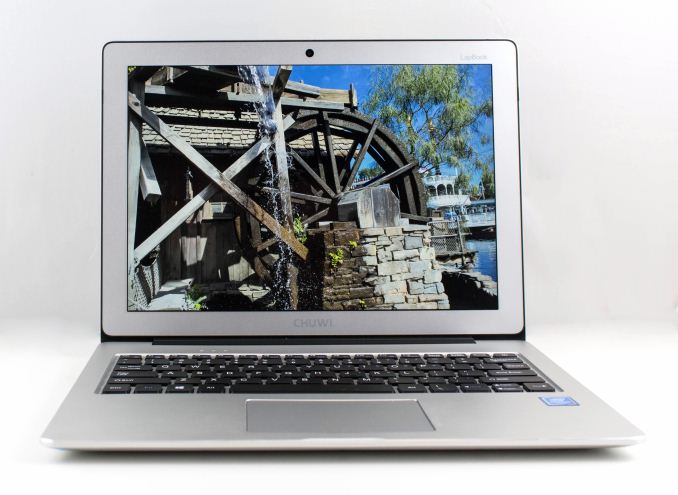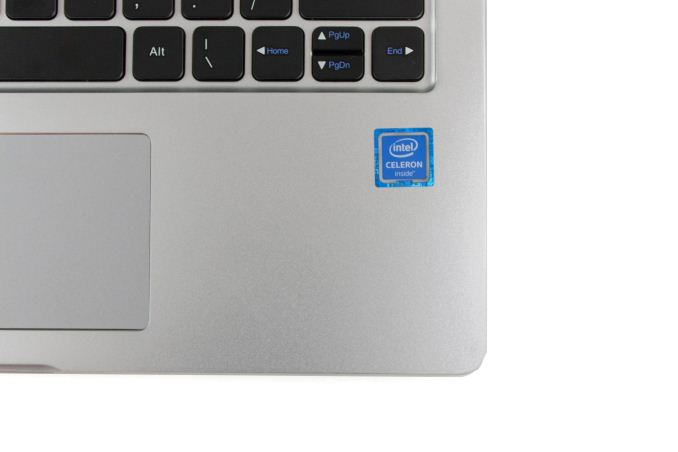The Chuwi LapBook 12.3 Review: Premium Feel, Budget Price
by Brett Howse on September 6, 2017 8:00 AM EST- Posted in
- Laptops
- Apollo Lake
- Goldmont
- Chuwi

Every once in a while, we get surprised. It seems to be a rare thing in this industry these days, but it does still happen from time to time. The Chuwi Lapbook 14.1 was one such surprise when we reviewed it earlier this year. Chuwi hasn’t been around for a long time, but in one fell swoop, they forever changed the expectations on a budget laptop. Reasonable components, coupled with a good IPS display, instantly changed the expectations on any budget offering from the big PC makers. So far, they’ve not really responded, and the LapBook 14.1 is easily the top pick for anyone wanting a 14-inch laptop for not a lot of money.
So, imagine the shock when this still relatively unknown PC maker surprised us again. Earlier this year, they announced the LapBook 12.3, which is now available. It takes the same basic internals from the LapBook 14.1, couples it to the same display found in the Surface Pro, and packs it all into an all-aluminum chassis. The budget bar has been raised again.
The underlying platform is almost unchanged from the LapBook 14.1 that we reviewed in March. At the heart is an Intel Celeron N3450 CPU, which is a quad-core processor based on the Intel Atom lineup, but the latest Goldmont architecture. This isn’t going to be a blisteringly fast laptop, but the N3450 holds its own in light tasks. In addition, Chuwi has bumped the RAM from 4 GB in the LapBook 14.1, to 6 GB in the LapBook 12.3. That’s a very respectable amount for this PC. Storage remains the same 64 GB of eMMC, which isn’t a lot, but is much better than the 32 GB seen in most PCs in this price range. The LapBook 14.1 also had an M.2 slot inside where you could add a SSD if desired, and the LapBook 12.3 makes that even easier with a removable panel on the bottom to access the M.2 slot.
| Chuwi LapBook 12.3 | |
| CPU | Intel Celeron N3450 4C/4T 1.1-2.2 GHz 2MB L2 Cache 6W TDP |
| GPU | Intel HD Graphics 500 12 Execution Units (Gen 9) 200-700 MHz |
| Memory | 6 GB Dual-Channel |
| Display | 12.3" 2736x1824 3:2 IPS |
| Storage | 64 GB eMMC Expandable up to +128GB microSD plus M.2 slot (2242 SATA) |
| I/O | 1 x USB 3.0 Port 1 x USB 2.0 Port 1 x micro HDMI micro SD Card Slot 1 x Headset Jack |
| Dimensions | 300 x 223 x 16.7 mm 11.8 x 8.78 x 0.66 inches |
| Weight | 1.45 kg / 3.18 lbs |
| Battery | 37 Wh, 24W AC Adapter |
| Wireless | Intel Dual Band Wireless-AC 3165 1x1 with Bluetooth 4.2 |
| Price | $310-$330 USD |
The star of the show though is the display, with its 267 pixels-per-inch. The 2736x1824 resolution means that it’s also a 3:2 display, giving a bit more display height than a standard 16:9 laptop, and for productivity tasks, that’s been a winning aspect ratio on Microsoft’s Surface lineup. There’s no touch though, but you can’t have everything for this price.
Speaking of the price, this all-aluminum laptop, with a higher resolution display, and more RAM than the LapBook 14.1, can still be had for around the $300 USD mark. At the time of this writing, it’s going for $330 on Amazon, compared to $270 for the larger, plastic, LapBook 14.1, and it can be found for less on other sites. That’s a remarkable price for a device with these kinds of features, and you’d be hard pressed to find a computer that offers more, for less. Let’s dig into the Chuwi LapBook 12.3.











60 Comments
View All Comments
tipoo - Wednesday, September 6, 2017 - link
Kind of impressive that a 3-issue core can get 70% of the way to Broadwell. Broadwell is still experientially better even with half the cores, but of course much higher power. Goldmont seems like a welcome de-crapping of Braswell.tipoo - Wednesday, September 6, 2017 - link
When you say two finger scroll is the opposite way as most laptops, do you mean scrolling down = content goes down, or the "natural" method where content tracks your fingers, push up to get to the bottom of a document?
Samus - Wednesday, September 6, 2017 - link
Yes, what is sometimes referred to as "natural" scrolling, opposed to "reversed" scrolling. Think of a flight sim where down is up and up is down.Personally, I find natural annoying (the default on Mac's) and always reverse it.
reukiodo - Thursday, September 7, 2017 - link
There is nothing natural about 'natural' scrolling. Only Mac users that have been exposed (forced) to this for a long time think this is normal. Every other human being, including kids and grandparents, by default move down to scroll down.peterfares - Thursday, September 7, 2017 - link
Windows computers nowadays use "natural" scrolling direction.I think the reasoning is the touchpad is basically "mapped" to the screen. You drag on the touchpad just as you'd drag on a touch screen which many of these laptops have nowadays.
JoeMonco - Saturday, September 9, 2017 - link
Except when using a tablet or smatphone, right?pjcamp - Tuesday, November 21, 2017 - link
Because "natural scrolling" maps exactly onto how one reads a sheet of paper -- lock your eyes in a specific direction and move the paper upwards through your field of view.Oh wait . . . .
R3MF - Wednesday, September 6, 2017 - link
Re: Linux supportAtom architectures very frequently have problems with standard linux distro's, in that they have crippled EUFI bios's, either 32bit only, or in some other way borked.
Can you install Suse or ubuntu to see if a stanard Grub2 beraing distro release can be installed on this laptop?
ThortonBe - Wednesday, September 6, 2017 - link
I would be keen to hear the answer to this as well. It seems like a pretty tempting device, but I'd want Linux on it.abufrejoval - Thursday, October 26, 2017 - link
I didn't actually install Ubuntu, but booted it from a USB stick. The BIOS has all the required settings to make Linux work in general and Ubuntu 16.04.03 had no issue with any of the hardware parts. I'm very sure it would run without any issues, just as it runs fine on the Braswell and Baytrail Atoms I own.Didn't try SuSE, CentOS etc. or Remix either.
I returned the notebook before running really extensive tests because
* M.2 slot can only hold 4cm units (I only have 8cm ones in the recyling bin)
* space bar only worked half the time (thumb keeps hitting metal strip between space bar and touch pad)
* touch pad sensitivty is far too high, cannot be truned off or configured: It's a nightmare to type on the thing
I bought it for €400 on Amazon Germany, they raised the price to €500 afterwards--somebody must have had one too many...
It came with version 1511 of Windows 10 which went out of support the day I received it. The upgrade took almost a day but was definitely worth it: It only ever ran the CPUs to full 2.1/2.22 tilt after that and Geekbench scores became quite impressive.
Reading PDFs full screen with two pages side-by-side on that display is what it seems to have been made for: Simply glorious!
A "good-enough" laptop without any moving parts, fan or disk, remains on my wish list. They were close, but fouled up the end-game.